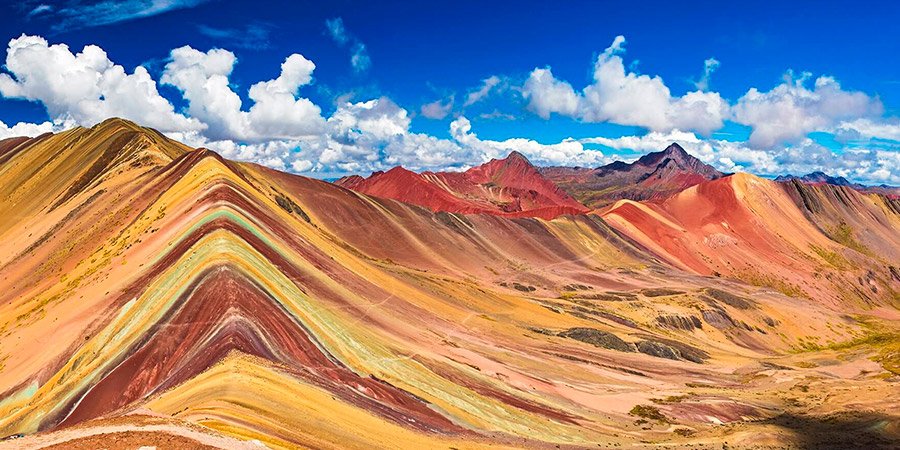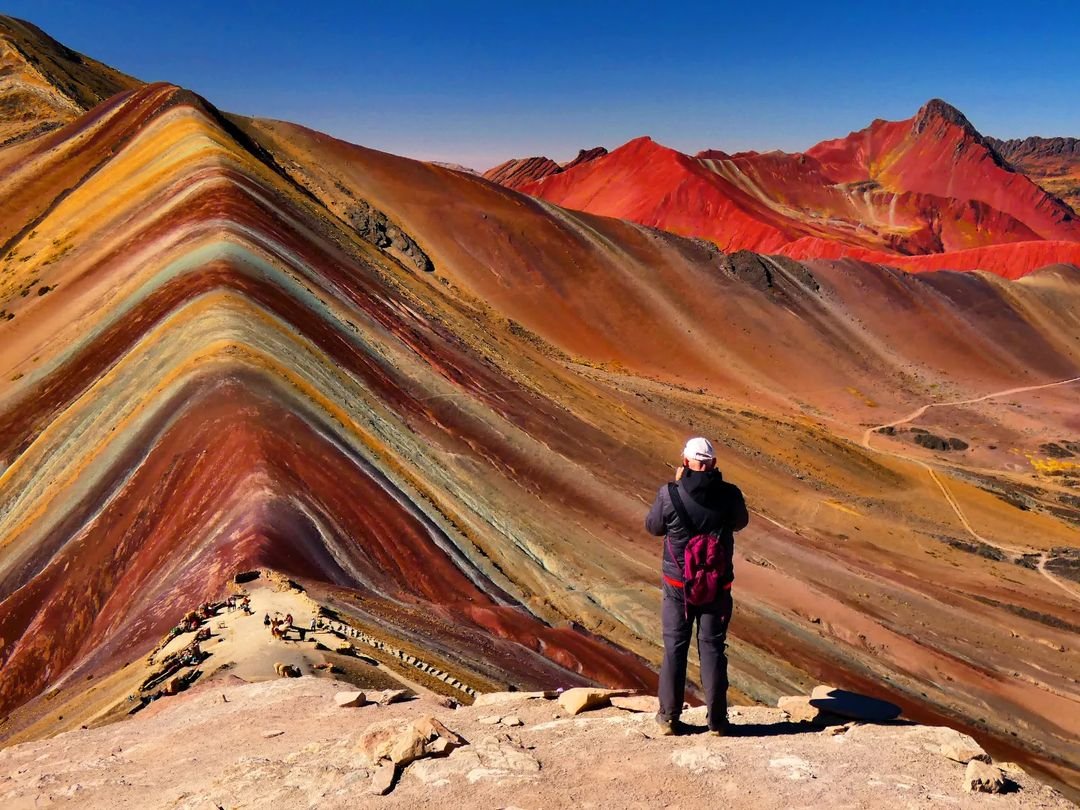Rainbow Mountain | Vinincunca
Vinicunca Mountain, also known as the Mountain of Seven Colors or Rainbow Mountain, is located in the Cusco region of Peru. Specifically, it is located in the Andes Mountains, near the town of Pitumarca, in the province of Quispicanchi.
“Vinincunca” is a word that comes from the Quechua language, which is spoken by many communities in the Andes of Peru and other countries in the region. In Quechua, “Vinincunca” can be broken down as follows:
“Vini”: this term could be related to “wini”, which means “nine” in Quechua. “Cunca” or “Cunqa”: It refers to “colors” in Quechua.
So, “Vinincunca” could be interpreted as “nine colors”. Although some say it refers to the nine colors that can be found in the mountain, the most common is to interpret it as “mountain of seven colors”, which could be due to an adaptation or simplification of the original expression. In any case, Vinicunca Mountain is known for its spectrum of unique and vibrant colors that make it stand out among the Andean landscape.
It is located at an approximate altitude of about 5,200 meters above sea level (approximately 17,060 feet). However, the altitude may vary slightly depending on the exact location on the mountain being measured. It is important to keep in mind that this altitude makes it a high altitude zone, which can present additional challenges for hikers and visitors who are not accustomed to such altitudes. It is advisable to take precautions and acclimatize properly before engaging in any activity in this region.
History of Vinicunca Mountain
Vinicunca Mountain, also known as Seven Colors Mountain or Rainbow Mountain, has been a sacred and significant place for local communities in the Cusco region of Peru for centuries. However, it became known worldwide in recent years due to its stunning natural beauty and unique geological features.
For a long time, the mountain was covered by a thick layer of snow and ice, hiding it from most people’s view. However, with climate change and global warming, the ice began to melt, revealing the distinctive layers of minerals and sediments that give the mountain its multicolored appearance.
The geological process that created this natural wonder dates back millions of years, when plate tectonics and volcanic activity formed the Andes Mountains and the mineral deposits found in the region. The combination of minerals such as clay, limonite, calcite and others, along with erosion caused by water and wind, resulted in the distinctive bands of colors that can be seen on the mountain today.

As Vinicunca Mountain became more accessible due to melting ice and growing tourist interest in the Cusco region, it became a popular destination for hikers and adventurers seeking to experience its unique beauty. Tourism has provided economic opportunities for local communities, but has also posed challenges in terms of environmental and cultural preservation.
Vinicunca Mountain is now a symbol not only of the impressive geology of the Andes, but also of the importance of protecting and preserving unique natural and cultural sites around the world.
How to get to the “Vinincunca” Mountain of Colors
To get to Vinicunca Mountain, also known as Seven Colors Mountain or Rainbow Mountain, you usually start from the city of Cusco, Peru. Here are some common options to get to the mountain:
Organized tour: This is the most popular and convenient way to get to Vinicunca Mountain. Many travel agencies in Cusco offer guided tours that include transportation from the city to the starting point of the hike up the mountain. These tours usually include transportation by bus or minibus and may offer additional services such as guides, meals and hiking equipment.
Public transportation and independent hiking: Another option is to take a bus or cab from Cusco to the village of Pitumarca, which is the common starting point for the hike to Vinicunca Mountain. From Pitumarca, you can walk approximately 6 to 7 kilometers until you reach the beginning of the trail that leads to the mountain. This option is more adventurous and requires a little more planning and preparation.
Private vehicle rental: Some people choose to rent a private vehicle from Cusco to the starting point of the trek. This offers more flexibility in terms of schedules and stops along the way, but can also be more expensive than other options.
Regardless of the method you choose, it is important to remember that Vinicunca Mountain is at high altitude and the hike can be challenging, especially for those who are not accustomed to the altitude. It is crucial to take time to acclimatize properly in Cusco before embarking on the trek and to carry enough water, sun protection and adequate clothing for the changing weather conditions in the region. Also, respect the natural environment and follow the indications of the local guides to preserve this beautiful place.
Recommendations for visiting the colorful mountain “Vinincunca”
Acclimatization: The altitude in the Cusco region, where Vinicunca Mountain is located, may affect some people, especially if they arrive from places at sea level. Take a couple of days to acclimatize in Cusco before starting the trek to the mountain.
Appropriate clothing: The climate in the Andean region can be unpredictable, with sudden changes in temperature and weather conditions. Wear comfortable clothing suitable for hiking, including layers to adapt to temperature changes. A good pair of hiking boots is a must.

Sun protection: Sun radiation at high altitude is intense, so be sure to bring adequate sun protection, such as sunscreen, sunglasses and a wide-brimmed hat.
Hydration and nutrition: Stay hydrated throughout the hike. Bring plenty of water and some energy snacks to keep your energy levels up. Avoid excessive alcohol and caffeine, which can contribute to dehydration.
Respect for the environment: Vinicunca Mountain is a natural and sacred place for the local communities. Respect the natural environment, do not leave garbage and follow the indications of the local guides to preserve the area.
Take your time: The hike up Seven Colors Mountain can be challenging due to the altitude and uneven terrain. Take your time, rest when necessary and do not push yourself beyond your physical limits.
Hire a guide: If possible, consider hiring a local guide for your visit. Not only will they provide you with interesting information about the area, but they will also help you navigate the terrain and ensure your safety.
By following these recommendations, you will be able to enjoy your visit to Seven Colors Mountain to the fullest while remaining safe and respectful of the natural and cultural environment.












